Review: ABOVE THE FOLD by Julie Zaffarano, Filigree Theatre
by David Glen Robinson
Imagine a distorted thrust stage, visibly twisted back to the 1930s by the powerful flow of time. The playing space established on the concrete-floored quonset hut of Factory on Fifth is a very large rectangle. Two sides are the upstage portion, the long dimension established with a long, ornate hotel bar. The shorter side offers an exit door set in a floral-design wallpapered wall and, to the downstage end, an elevated area with 1930s-period couch, lamp, and chairs. Everything else matches.
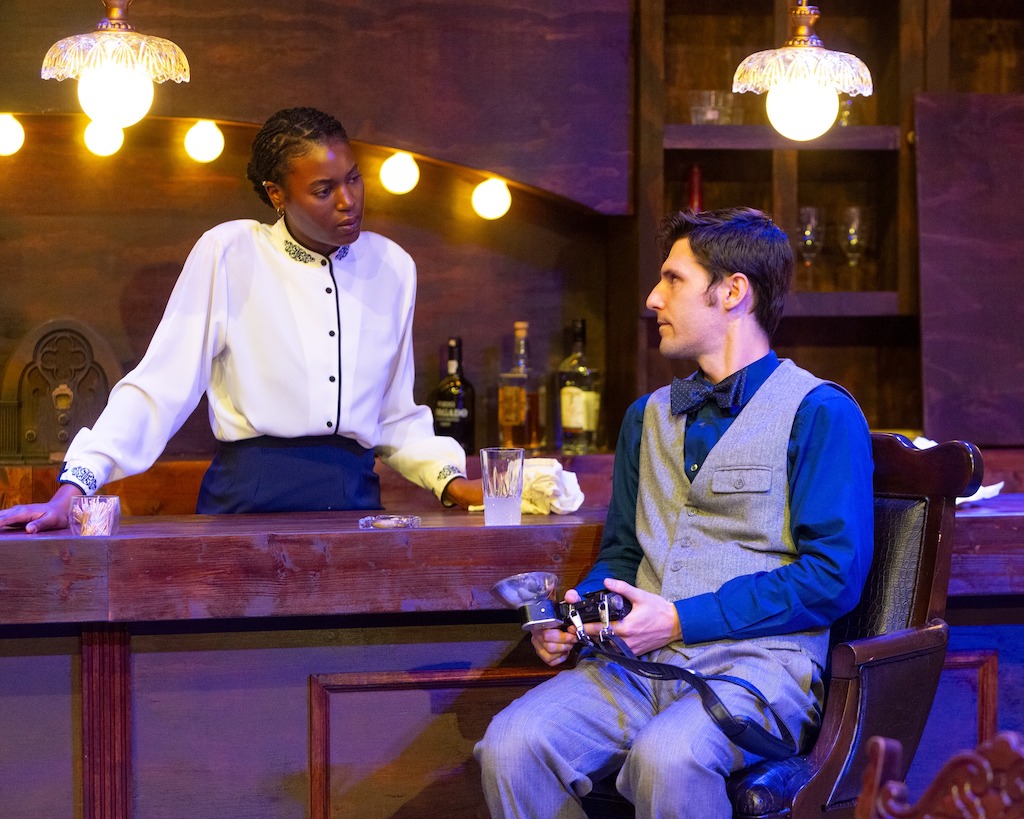
The floor is covered by a huge carpet spread below upscale hotel-lobby tables and chairs. The vertex on the diagonal opposite the upstage back corner of the set is open. Most of the entrances and exits are through it. Some are through the audience on two sides. That diagonal describes the off-center of the thrust, hence its distortion. Primary credit for the set and its initial strong impression goes to set and lighting designer Patrick Anthony. Filigree Theatre's artistic director Elizabeth V. Newman directs Above the Foldby Julie Zaffarano
The disorientation initially created by the set’s asymmetry is dispelled when reporter characters rush in to grab telephones and report accounts of a hearing at the courthouse a few blocks away. Three stage telephones are set at stations around the stage. The audience pieces together the background of the story line-by-line from the three reporters barking phrases to rewrite men at their papers. It's a clever bit of exposition, but the audience must be on its toes to capture it.
The reporters are dumping accounts of the ongoing proceedings of an inquest into the death of the showgirl/dancer/singer Evelyn Hoey in the mansion bedroom of her millionaire boyfriend Henry Rogers. Playwright Zaffarano takes the incident and individuals from an actual historical scandal in 1935.
These fictional reporters and hotel staff populate the hotel bar. As was true both in the 1930s and today, the reporters are competitive, seeking to scoop the others in every detail. The most aggressive is Roy of the New York Times, played by Julius Alums. He harasses and bullies the others and is exasperated by having to spell his words over the phone to the nearly illiterate assistant on the other end of the line. Alums plays Roy with fury, clarity, arch humor and not one ounce of sympathy for colleagues or victims. He’s ultimately a loser at life, though at the end he will reveal a crack in his hard shell by caring for his colleagues.
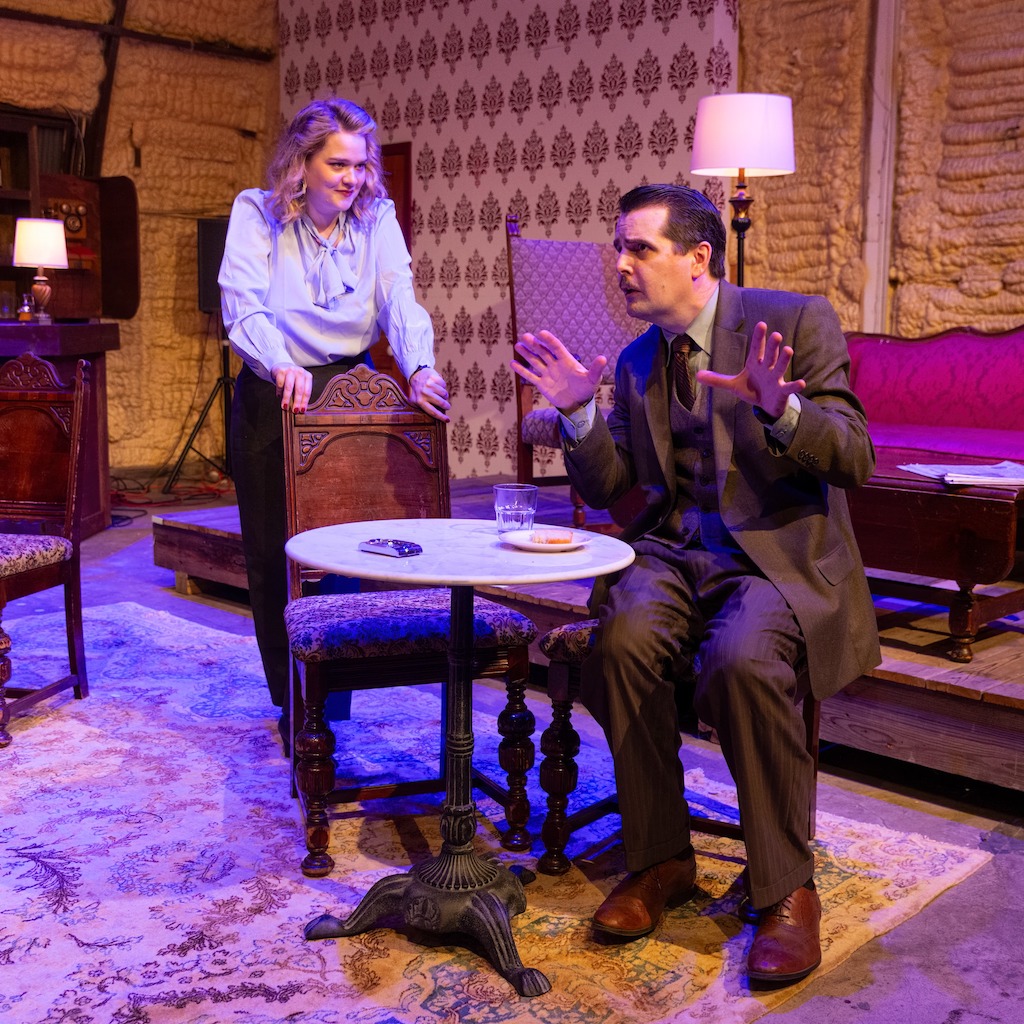 Sick and tired of his own shell is Carl, played by Shane Cullum, whose burnout is reflected in flaccid, anemic, cliché-ridden, and lackluster story posts dictated down the phone line. We see instantly that Carl wants to molt, to break his shell with the energy of passion, to rise on butterfly wings of love for his colleague Dorothy, played by Maddie Scanlan. She is the woman in the story, the exemplar of Filigree Theatre’s fifth-season theme The Woman in the Story.
Sick and tired of his own shell is Carl, played by Shane Cullum, whose burnout is reflected in flaccid, anemic, cliché-ridden, and lackluster story posts dictated down the phone line. We see instantly that Carl wants to molt, to break his shell with the energy of passion, to rise on butterfly wings of love for his colleague Dorothy, played by Maddie Scanlan. She is the woman in the story, the exemplar of Filigree Theatre’s fifth-season theme The Woman in the Story.
Carl and Dorothy work for different papers. They’ve been around the block once already, back when she was an ambitious cub reporter well in need of the nurture Carl amply provided. Professional pressures drove them apart. Carl’s the one who keeps dragging his broken toys back to play with Dorothy. Her sights are set on higher things, or so she thinks.
Carl has an advanced drinking problem. All the characters except Minnie, played by the one-name Toluwani, have serious nicotine habits. Tobacco smoke shows no respect for the fourth wall and made for considerable discomfort in the audience despite the spacious ceiling arch of Factory on Fifth.
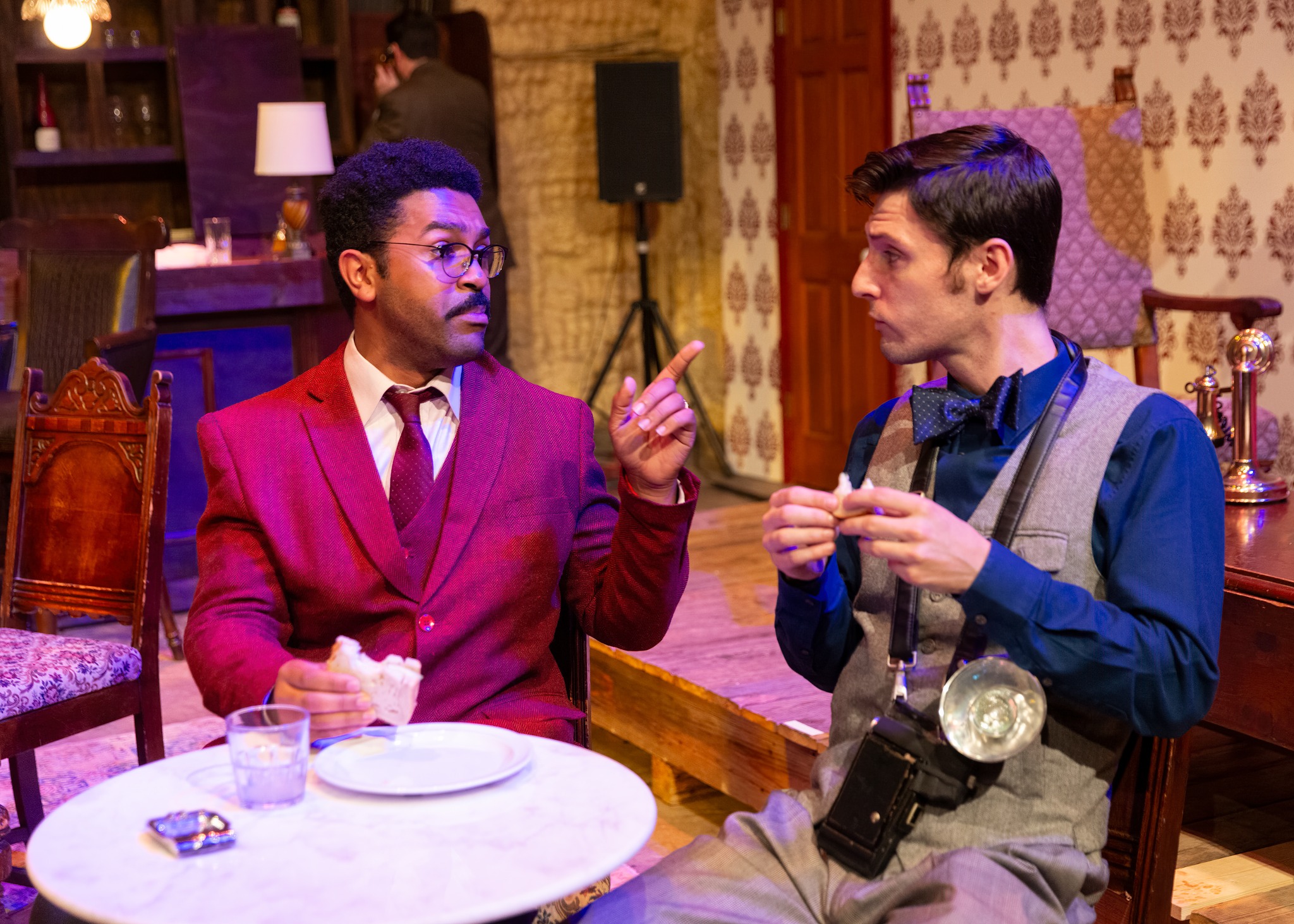 Rounding out the cast are Joe Kelley as George and Angela J. Latham as Mrs. Hoey, Evelyn Hoey’s mother. George is the cub reporter assigned by the Times to take photos at the inquest for Roy. Roy criticizes George’s shooting, and George makes hilarious excuses and fumbles everything. He says a second camera would solve the problem, but everyone knows secretly that the change would move them all from catastrophe to disaster.
Rounding out the cast are Joe Kelley as George and Angela J. Latham as Mrs. Hoey, Evelyn Hoey’s mother. George is the cub reporter assigned by the Times to take photos at the inquest for Roy. Roy criticizes George’s shooting, and George makes hilarious excuses and fumbles everything. He says a second camera would solve the problem, but everyone knows secretly that the change would move them all from catastrophe to disaster.
Kelley’s George is a strong contrast to his role as Edgar Allan Poe in Archive Theater’s The Raven-Winged Hours, reviewed by CTXLT last September. It’s delightful to be able to compare an actor's performances demonstrating such character breadth.
Angela J. Latham as Mrs. Hoey creates a marvelous character of the aggrieved 1930s woman. She serves as a foil to Dorothy, the thoroughly modern Millie reporter pushing the 30s into the 40s. Mrs. Hoey strongly articulates the values of her generation, in particular denigrating journalism that tramples people’s lives for its own gain. Her dialogues and speeches give a healthy contrast to the winner-take-all values espoused by the reporters, and they certainly resonate today.
We hear more and more about murder victim Evelyn Hoey and her lover, but nothing definitive about Hoey’s death. As we learn more about Dorothy and Carl, we begin to see them as out-of-time doppelgangers of Evelyn and Henry, notably when, for research purposes, Dorothy and Carl try to reenact Evelyn’s and Henry’s final interaction, with the Chekhovian firearm.
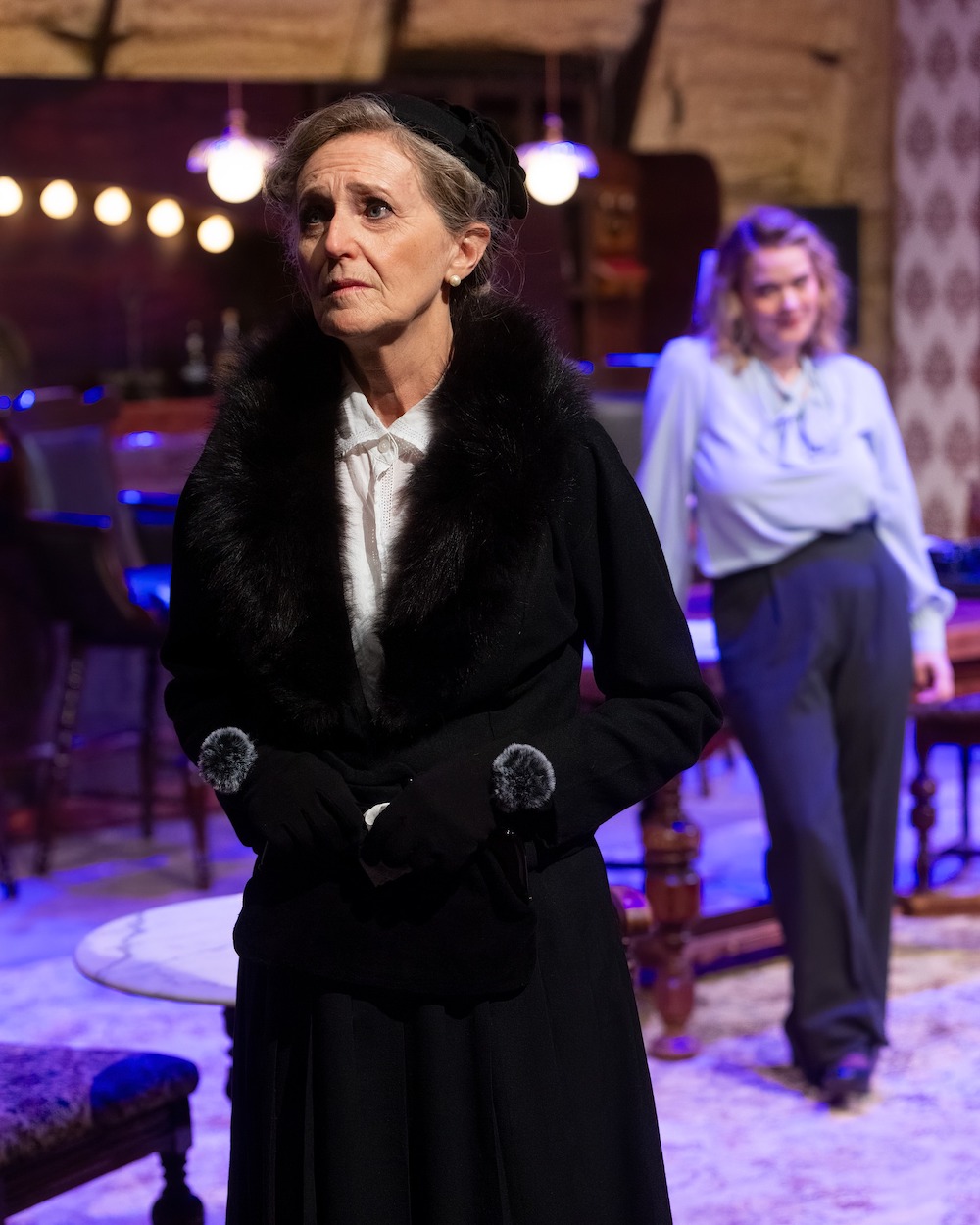
Dorothy's story is a true-to-life account of the obstacles women encountered in 1930s journalism, one of many boys-only clubs in American life in the decade. The bandwidth of stories of women’s plight is widened when Minnie and Mrs. Hoey offer their own stories, each involving tragedies. But Dorothy’s increasing adeptness at playing the boys’ game leads her to the moral stumble of deceiving and lying to Mrs. Hoey to gain her story. The boys find out and pounce on her, leading to Dorothy’s despair and eventual confession to Mrs. Hoey, who refuses to forgive her. Dorothy’s crisis of conscience leads her to question everything, including her relationship with Carl. Eventually, the emotional link between herself and Carl, that deep interior knowing, allows both to intuit the truth between the fatal lovers. Intuition is woman’s way.
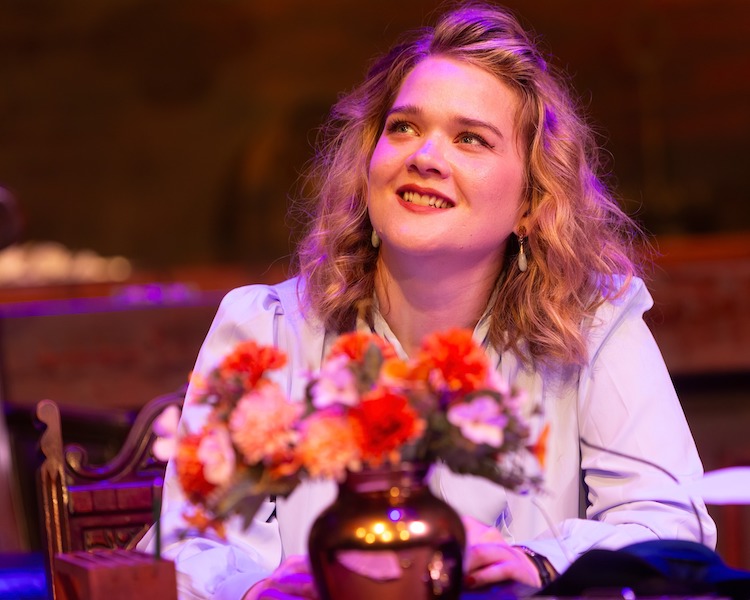
Above the Fold gives us a workshop on 1930s journalism with this story.That was an era well before the cyber revolution. Today the vast majority of Gen-Z adults get their news from social media rather than newspapers, TV, or cable programming. In the 30s, stories moved at the speed of reporters running to the nearest phone and begging to reverse the charges. The play gave several examples. It’s notable that the reporter’s skill at the written word, spoken from notes into telephones with correct spelling, could mean scoops or not, promotions or not, raises or not.
A minor quibble: before digital imaging, all photographs were produced by silver compound development in wet baths. The pace was slower than text processing by hand or typewriter, but that greater time lag was not suggested in the production of several important photos by George (those leading to discovery of Dorothy’s consequential lying to Mrs. Hoey). Did young and inept George develop his own photos in a field darkroom set up in the hotel? We doubt it. But overall, Above the Fold gave us exceptional access to 1930s newspaper life, including most reporters’ crutches of tobacco and drink.
Above the Fold is a complex yet satisfying play installed in an intriguing new venue, Factory on Fifth, well set up for the production. We look forward to future productions by Filigree Theatre there. Above the Fold runs until April 30, 2024.
Above the Fold
by Julie Zaffarano
Filigree Theatre
April 18 - April 28, 2024
April 18 - 28, 2024
Thursdays - Sundays
Factory on FIfth, 3409 E 5th St., Austin, TX 78702 (click for map)
Website: www.filigreetheatre.com
